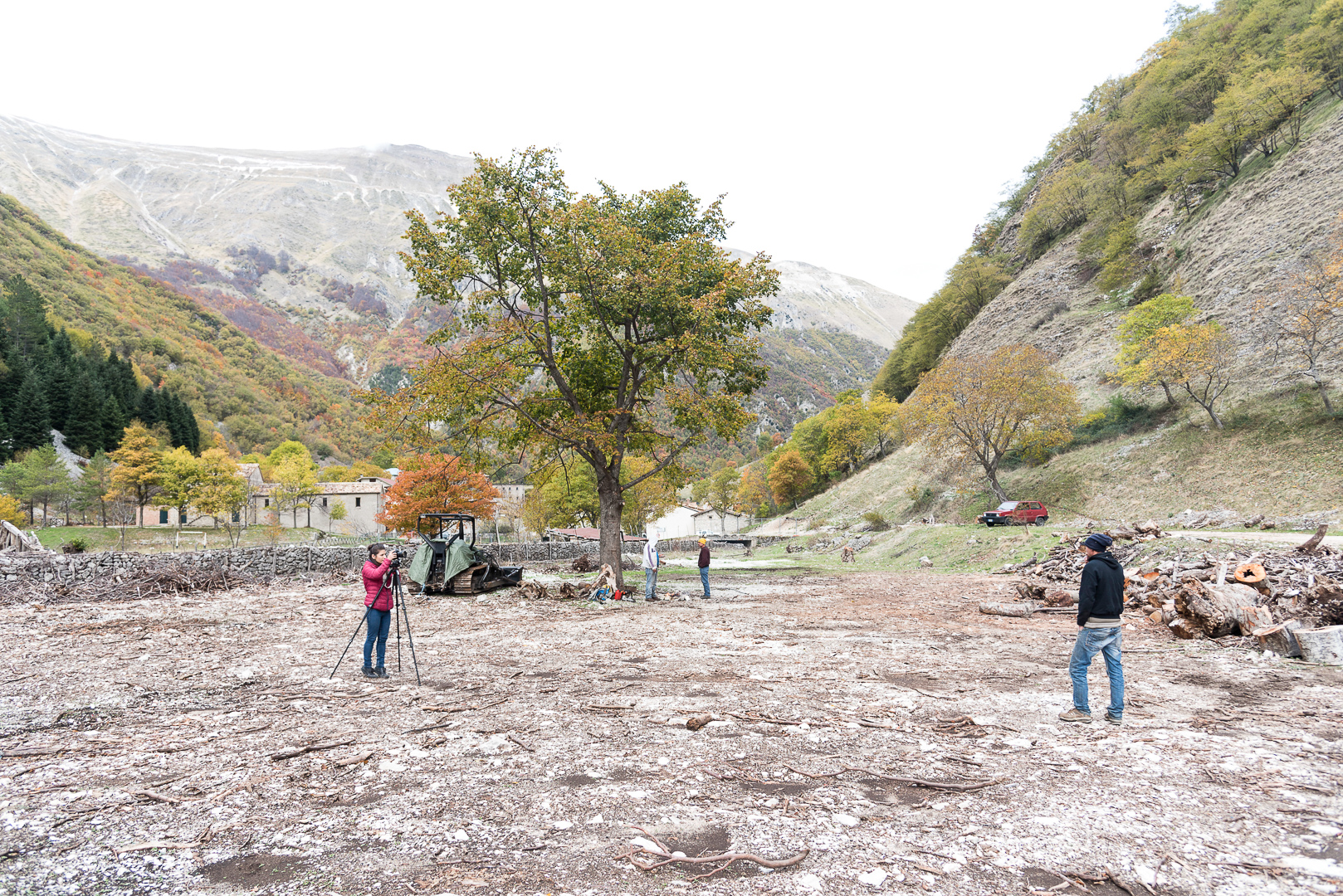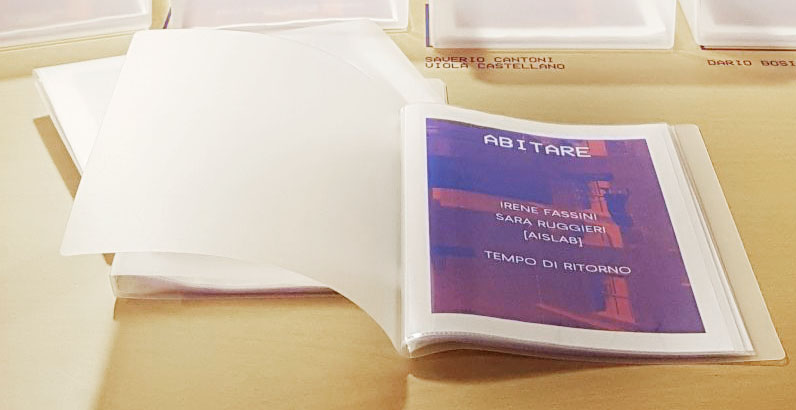Apennine mountains, on going
Tempo di ritorno / Return period
tèmpo [lat. tĕmpus, di etim. discussa]
s. m.
di ritòrno [da
ritornare]
s. m.
1 Stimatore della ripetitività del fenomeno
sismico.
2 Movimento per ripensare i luoghi ai margini e
ripartire.
Return (lat. tempus, of etim. discussed)
period
1 Estimate of the likelihood of an earthquake.
2 Afterthought of marginal places.
A seguito di un precedente lavoro di documentazione per Lo Stato delle cose dei
luoghi e delle comunità colpite dal terremoto, sentiamo
l’esigenza di operare nelle comunità dall’interno scegliendo
di utilizzare il video e la fotografia non come strumenti di una
nostra narrazione, ma come strumenti che diano voce alla
narrazione della comunità stessa.
After a previous documentary project for Lo Stato delle cose dealing with communities affected by earthquake, we feel the need to move on withto use video and photography as tools that give voice to the community itself.

Abitare temporaneo - abitare a lungo termine
La ricerca si sviluppa all’interno di tre comunità montane
dell’Appennino coinvolte dal terremoto del 2016, Montegallo,
Arquata del Tronto e Amatrice, luoghi fragili sia da un punto
di vista fisico sia politico. Qui il processo di spopolamento e
abbandono già in atto è stato accentuato dalle conseguenze
del terremoto. L’urgenza di indagare queste realtà
periferiche, ma peculiari del contesto italiano, ambisce
a lavorare sulla rottura della geografia del paesaggio
che si è creata dopo il sisma. Le comunità sono rilocate
in Sae (Soluzioni abitative di emergenza), strutture
prefabbricate, smontabili e riconvertibili che si legano al
nucleo abitativo originario in modo differente a seconda
delle diverse modalità di ricostruzione. Dato il tempo
medio di ricostruzione dei borghi storici che varia da 5 a
10 anni, nel lungo periodo le aree Sae da contesti abitativi
emergenziali diventano veri e propri insediamenti dove
l’abitare temporaneo diventa permanente.
From temporary to permanent dwelling
The research focuses on three communities of the Apennines involved in the 2016 earthquake: Montegallo, Arquata del Tronto and Amatrice. Here the process of depopulation and abandonment has been accentuated by the consequences of the earthquake. We aim to investigate the way these communities recreate a new geography of the landscape after the earthquake. The communities are relocated in Emergency Housing Solutions, prefabricated structures, demountable and reconvertible that are linked to the original housing nucleus in different ways according to the different reconstruction methods. Given the average time of reconstruction of the historic villages (ranging from 5 to 10 years), in the long run the Sae areas from emergent housing contexts become real settlements where the temporary dwelling becomes permanent.
 Emergency housing under construction (Sae), Montegallo, Marche, december 2017
Emergency housing under construction (Sae), Montegallo, Marche, december 2017
The project purpose and the working method
house / home
Le case Sae (house) diventano così i luoghi di un tempo e di uno
spazio sospesi dei quali gli abitanti si riappropriano solo grazie alla
ri-costruzione attiva della dimensione simbolica e identitaria della
casa (home). Il processo di ricostruzione attivato dalle istituzioni,
impositivo e assistenziale, impedisce invece la ricomposizione
di un sé individuale e collettivo che può avvenire solo con un
processo di ricostruzione attivo e partecipato. La ricerca intende
muoversi proprio in questo spazio di incapacità di risposta da
parte delle istituzioni ai reali bisogni dei cittadini, innescando un
processo attivo di rielaborazione dell’abitare del passato attraverso mappe geografiche della memoria.
Si chiederà prima alle persone
rilocate nei nuovi insediamenti di raccontare attraverso un disegno
l’abitare del passato, sia quello intimo della propria casa sia quello
in relazione al contesto. Il disegno-racconto, che è una mappa
della memoria e dei ricordi, sarà realizzato e filmato nella nuova unità
abitativa emergenziale. Il video, che ha una
durata variabile corrispondente al fluire della memoria, è la raccolta
del momento di riappropriazione dell’abitare, quando l’abitazione
torna a essere casa.
La seconda fase del lavoro avviene invece
in un contesto comunitario. Le mappe della memoria saranno
prima interpretate e poi ricucite insieme agli abitanti, sia in senso
simbolico sia fisico, nella mappa collettiva.
The inhabitants of the Sae- Emergency housing (HOUSE) have to reappropriate the symbolic and identity dimension of the HOME through an active and participated process. Instead, the post-earthquake reconstruction process by the institutions prevents the reconstruction of an individual and collective self. The research aims to fill this gap, giving voice to citizens and triggering an active process of rielaboration.
People relocated to new settlements will be asked to tell through a drawing their way of living, intimate and collective, before the earthquake.
First of all, the people relocated to the new settlements will be asked to draw the story of their way of living in the past. The drawing-story / map of memory will be realized in the new emergency housing unit and filmed by the authors. The video, which has a variable duration corresponding to the flow of memory, will record the moment when the house returns to being home.
The second stage expects the involvement of the inhabitants of the Sae who will stitch together the maps with the help of a psychologist.

The research project





Call for Projects Abitare
The project Tempo di ritorno
was selected among the 50 finalist projects of the call Abitare: sette sguardi sul paesaggio fisico e sociale dell’Italia di oggi promoted by MiBACT in collaboration with La Triennale di Milano and the Museum of Contemporary Photography.



